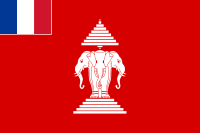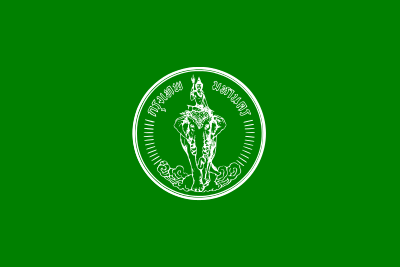Airavata
| Airavata | |
|---|---|
 Indra (alias Sakra) and Shachi riding the five-headed Divine Elephant Airavata, Folio from a Jain text, Panch Kalyanaka (Five Auspicious Events in the Life of Jina Rishabhanatha), circa 1670-1680, Painting in LACMA museum, originally from Amber, Rajasthan |
Airavata is a mythological white elephant who carries the Hindu god Indra. It is also called 'abhra-Matanga', meaning "elephant of the clouds"; 'Naga-malla', meaning "the fighting elephant"; and 'Arkasodara', meaning "brother of the sun".[1] 'Abhramu' is the elephant wife of Airavata. Airavata has ten tusks and five trunks and is spotless white. It is also known as Erawan in Thai. Airavata is also the third son of Kashyap and Kadru. In the Mahabharata he is listed as a great serpent.[2]
In Hindu traditions
According to the Ramayana, the elephant's mother was Iravati. According to the Matangalila, Airavata was born when Brahma sang sacred hymns over the halves of the egg shell from which Garuda hatched, followed by seven more male and eight female elephants. Prithu made Airavata king of all elephants. One of his names means "the one who knits or binds the clouds" since myth has it that these elephants are capable of producing clouds. The connection of elephants with water and rain is emphasized in the mythology of Indra, who rides the elephant Airavata when he defeats Vritra. This mighty elephant reaches down his trunk into the watery underworld, sucks up its water, and then sprays it into the clouds, which Indra then causes to rain forth cool water, thereby linking the waters of the sky with those of the underworld.
As per another legend, Airavatha is believed to have come out of churning the Ocean of milk and it is believed that the elephant guards one of the points of compass.[3] Airavata also stands at the entrance to Svarga, Indra's palace. In addition, the eight guardian deities who preside over the points of the compass each sit on an elephant. Each of these deities has an elephant that takes part in the defense and protection of its respective quarter. Chief among them is Airavata of Indra. There is a reference to Airavata in the Bhagavad Gita:
"Of horses, know Me to be the nectar-born Ucchaisravas; of lordly elephants, Airavata and of men, the monarch."[4]
At Darasuram near Tanjore is a temple where it is believed that Airavata worshipped the Lingam; the Lingam is named after him as Airavateswara. This temple, which abounds in rare sculpture and architectural workmanship, was built by Rajaraja Chola II (1146–73).
Jain tradition
In Jain tradition, when a Tirthankara is born, Indra descends with his consort, Shachi, riding their mount, the great elephant Airavata, to celebrate the event.[5]
Flags with Airavata
- Laos
-

Flag of French Laos (1893-1952)
-
.svg.png)
Flag of Laos (1952-1975)
-

Laotian royal standard (1952-1975)
- Siam (Thailand)
Erawan
Erawan (Thai: เอราวัณ, from Pāḷi Erāvana, or Sanskrit Airāvana) is one of the Thai names of Airavata. It is depicted as a huge elephant with either three or sometimes thirty-three heads which are often shown with more than two tusks. Some statues show Indra, the king of Tavatimsa Heaven, riding on Erawan. The elephant is sometimes associated with the old Lao Kingdom of Lan Xang and the defunct Kingdom of Laos, where it was more commonly known as the "three-headed elephant" and had been used on the royal flag.[6]
In popular culture
Airavata is a recruitable character in the Shin Megami Tensei: Devil Survivor video game.
Airavata is referenced in the song The Animal Tent on the album The Circus by The Venetia Fair:
"Here comes Airavata; the elephant controls the rainclouds,His skin the rumbling earth (Airavata!)"
Airavata is the name of the Volvo bus service that Karnataka State Road Transport Corporation provides.[7]
Notes
| Wikimedia Commons has media related to Airavata. |
- ↑ Dowson, John (1870). A Classical Dictionary of Hindu Mythology and Religion, Geography, History, and Literature. London: Trübner & Company. p. 180.
- ↑ Ganguli, Kishori Mohan. "Mahabharata". Translation. Pratap Chandra Babu.
- ↑ Gopal, Madan (1990). K.S. Gautam, ed. India through the ages. Publication Division, Ministry of Information and Broadcasting, Government of India. p. 64.
- ↑ Bhagavad Gita (Chapter 10, Verse 27)
- ↑ Goswamy 2014, p. 245.
- ↑ Reynolds, Frank E., ed. (1982). Three worlds According To King Ruang: A Thai Buddhist Cosmology. Berkeley. ISBN 0-89581-153-7.
- ↑ "KSRTC launches Volvo buses with pantry and toilet". The Hindu. 19 July 2012. Retrieved 27 August 2014.
References
- Goswamy, B.N. (2014), The Spirit of Indian Painting: Close Encounters with 100 Great Works 1100-1900, Penguin Books, ISBN 978-0-670-08657-3


_(Rama_IV).svg.png)
_(Rama_V).svg.png)

